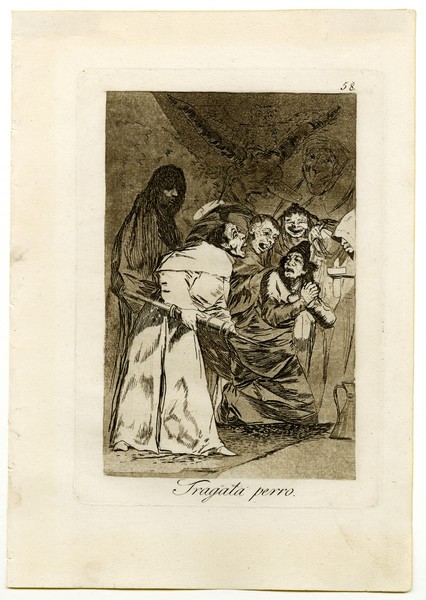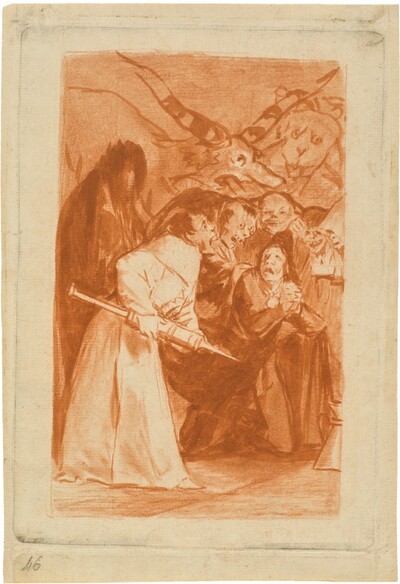- Cronología
- Ca. 1797 - 1799
- Dimensiones
- 218 x 152 mm
- Técnica y soporte
- Etching, burnished aquatint and drypoint
- Reconocimiento de la autoría de Goya
- Undisputed work
- Ficha: realización/revisión
- 26 Dec 2010 / 29 May 2024
- Inventario
- 225
Tragala perro. (at the bottom)
58. (in the upper right-hand corner)
See Francisco de Goya y Lucientes, Painter.
There is a state proof before the letter with burnished aquatint and drypoint in the National Library of Madrid.
In the first printings the title was misspelled, Tragala perro, until the error was corrected and the "r" was added.
A preparatory drawing for this engraving has survived.
A kneeling, supplicant man in the centre of the composition, slightly offset to the right, is surrounded by clerics. The one in the foreground, his face wild-eyed and his mouth open as if he were screaming, carries a huge syringe with which he threatens the unwary man. Another figure is holding him, while one in the background laughs, and two others at the sides seem to be watching the scene impassively. In the background, in the semi-darkness, several menacing-looking animal heads can be seen.
Goya used three-tone aquatint, which contrasts with the varnish reserves in the whites, especially in the figure holding the syringe, and he used drypoint in the veiled figure.
The Ayala manuscript describes this print as follows: "Some friars are trying to cure a poor Marcos, by hanging a relic around his neck and forcibly washing him". The one in the Prado Museum notes: "He who lives among men was irremediably stigmatised: if he wants to avoid it, he will have to go and live in the mountains, and when he is there he will also know that living alone is a geringa". Finally, the manuscript in the National Library refers to this print with the following comment: "A certain Juan Lanas is not given a bad wash by some friars who flirt with his wife and put a taleguillo around his neck as a relic to cure him and keep him quiet. The woman is seen behind covered with a veil and a monster with enormous antlers presides over the performance, with our Father Prior authorising it all".
Nigel Glendinning believes that the source of inspiration for this engraving could be found in some handwritten Tenths in Seville, of which several versions circulated, which relate a well-known anecdote of the time: the rivalry between an officer and a friar for the favours of a married woman. One day the officer goes to his beloved's house and finds her with the friar, to which the friar threatens to give her an enema, finally pulling out a pistol and having a maid give her not one but three. Thus the friar with the syringe would be identified with the friar in the story, the kneeling man with the officer and the veiled figure in the background with the woman. Behind the group stands an owl with its wings spread between the horns of a monstrous being that would symbolise the woman's husband or her lover. This creature has a large snout reminiscent of a phallus and next to it a face with a dog-like appearance and human reminiscences.
The title of the print has a double meaning, as the victim has no choice but to endure what is happening to her. The word "tragala" remained at the time an offensive term in the political vocabulary of 19th-century revolts. It was also included in liberal songs critical of the absolutist governments in power.
The plate is in rather poor condition, with the aquatint very worn (National Chalcography, no. 229).
-
Goya. Gemälde Zeichnungen. Graphik. TapisserienKunsthalle BaselBasle1953from January 23th to April 12th 1953cat. 243
-
Goya. Das Zeitalter der Revolucionen. Kunst um 1800 (1980 – 1981)Hamburger KunsthalleHamburg1980cat. 38
-
Goya. La década de Los CaprichosMadrid1992organized by Real Academia de Bellas Artes de San Fernando sponsored by Fundación Central Hispano, Madrid, consultant editor Nigel Glendinnig. From October 26th 1992 to January 10th 1993cat. 108
-
Francisco de GoyaMuseo d'Arte ModernaLugano1996exhibition celebrated from September 22nd to November 17th.cat. 58, p.85
-
Francisco Goya. Sein leben im spiegel der graphik. Fuendetodos 1746-1828 Bordeaux. 1746-1996Galerie KornfeldBern1996from November 21st 1996 to January 1997cat. 64
-
Goya e la tradizione italianaFondazione Magnani RoccaMamiano di Traversetolo (Parma)2006consultant editors Fred Licht and Simona Tosini Pizzetti. From September 9th to December 3th 2006cat. 58, p.160
-
Goya. Opera graficaPinacoteca del Castello di San GiorgioLegnano2006exhibition celebrated from December 16th 2006 to April 1st 2007p.39
-
Goya et la modernitéPinacothèque de ParisParís2013from October 11st 2013 to March 16th 2014cat. 198
-
The Monk and the Soldier in Plate 58 of Goya's CaprichosJournal of the Warburg and Courtauld InstitutesLondonThe Warburg Institute1961pp.115-120
-
Nuevos datos sobre las fuentes del Capricho nº 58 de GoyaPapeles de Son Armadans1963pp.13-29
-
Goya engravings and lithographs, vol. I y II.OxfordBruno Cassirer1964pp.133-134, cat. 93
-
Vie et ouvre de Francisco de GoyaParísOffice du livre1970p.183, cat. 567
-
Goya, la década de los caprichos: dibujos y aguafuertesMadridReal Academia de Bellas Artes de San Fernando1992pp.184-187, cat. 107-108
-
Goya. El capricho y la invención. Cuadros de gabinete, bocetos y miniaturasMadridMuseo del Prado1993p.240, fig. 168
-
Catálogo de las estampas de Goya en la Biblioteca NacionalMadridMinisterio de Educación y Cultura, Biblioteca Nacional1996p.104, cat. 147-148
-
El libro de los caprichos: dos siglos de interpretaciones (1799-1999). Catálogo de los dibujos, pruebas de estado, láminas de cobre y estampas de la primera ediciónMadridMuseo Nacional del Prado1999pp.302-305
-
ParísPinacoteca de París2013p. 264
-
Goya. In the Norton Simon MuseumPasadenaNorton Simon Museum2016pp. 42-75

